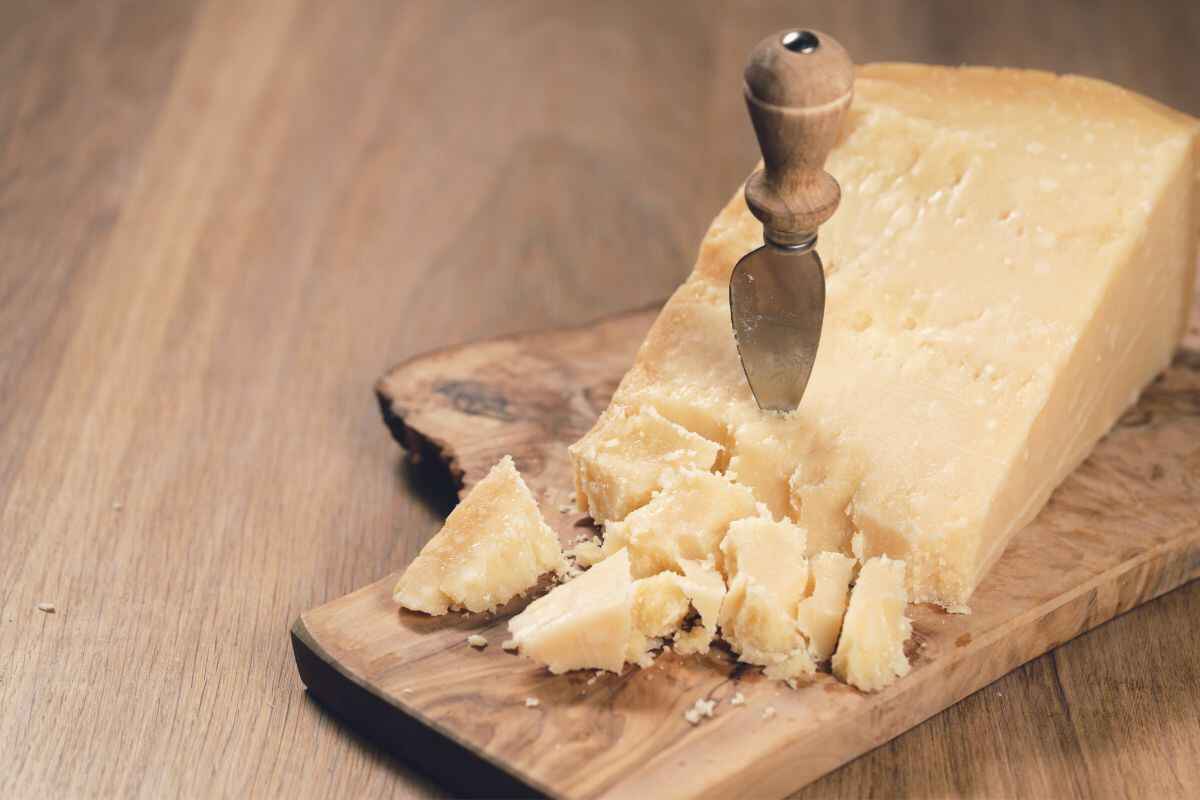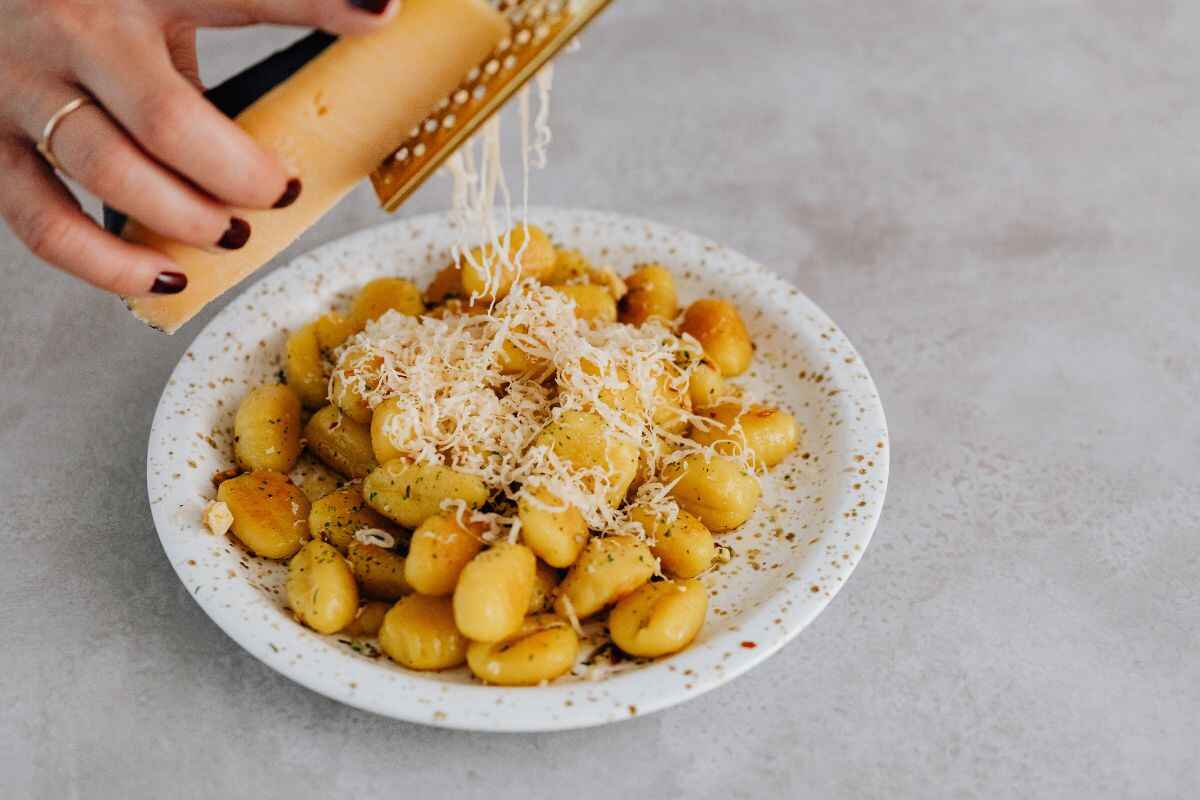What is Grated Parmesan Cheese?
Grated Parmesan cheese is a finely shredded version of one of Italy’s most famous cheeses. It has a nutty, salty flavor and a crumbly texture that makes it perfect for all kinds of dishes. Whether you sprinkle it on pasta, mix it into soups, or bake it into a crust, grated Parmesan adds a savory touch that makes simple meals taste amazing. 🧀✨
Table of Contents
The History of Parmesan Cheese
Parmesan cheese has been around for over 900 years! It was first made by Benedictine monks in the Parma region of Italy as a way to preserve milk. Thanks to its long aging process and hard texture, it could be stored and transported easily. Over time, it became a favorite across Europe, and now it’s loved all around the world for its rich flavor and traditional methods of production.
How is Parmesan Cheese Made?
The Traditional Process
Parmesan cheese, or Parmigiano-Reggiano, is made with just three ingredients: cow’s milk, rennet, and salt. The milk is heated, turned into curds, and pressed into molds. Then it’s aged for at least 12 months to develop its bold, nutty flavor and firm texture.
What Makes Parmesan Unique?
Only cheese made in specific parts of Italy can be called Parmigiano-Reggiano. This is because it has a special protected status, ensuring it follows traditional methods. Its long aging process gives it a unique, strong flavor and a slightly crunchy texture that makes it stand out from other cheeses.
Grated Parmesan Cheese vs. Shredded: What’s the Difference?
While grated and shredded Parmesan might seem interchangeable, there are subtle differences. Grated Parmesan is finely ground, resembling small crumbs or powder, making it perfect for sauces and sprinkling. Shredded Parmesan, on the other hand, has larger, more distinct pieces, ideal for melting or adding texture to dishes. Choosing the right one depends on the recipe—grated Parmesan blends effortlessly, while shredded adds a visual and textural element.
How to Choose the Best Grated Parmesan Cheese
Freshly Grated vs. Pre-Packaged
Whenever possible, opt for freshly grated Parmesan. Pre-packaged grated cheese often contains additives like anti-caking agents, which can affect its flavor and melting ability. Grating your own from a block ensures the freshest, most authentic taste.
Reading the Label: What to Look For
If you’re buying pre-packaged Parmesan, look for products labeled “Parmigiano-Reggiano.” Avoid anything labeled “Parmesan-style,” as these are often imitations made without adhering to traditional methods. Always check the ingredient list to ensure there are no unnecessary additives.
Common Uses for Grated Parmesan Cheese
As a Pasta Topping
One of the most popular uses for grated Parmesan is as a topping for pasta. Whether it’s spaghetti, lasagna, or ravioli, a sprinkle of Parmesan enhances the dish with its savory kick. It’s like the cherry on top of a sundae but for pasta! 🍝
In Soups and Stews
Adding grated Parmesan to soups like minestrone or stews like chicken cacciatore not only boosts the flavor but also thickens the broth slightly. It’s a simple trick that adds depth and richness to your bowl.
As a Key Ingredient in Recipes
Grated Parmesan is a star ingredient in many recipes. Think creamy Alfredo sauce, Parmesan-crusted chicken, or cheesy breadsticks. Its versatility makes it a staple in kitchens worldwide.

Health Benefits of Grated Parmesan Cheese
Nutritional Highlights
| Nutrient | Per 1 oz (28g) |
|---|---|
| Calories | 110 |
| Protein | 10g |
| Fat | 7g |
| Calcium | 30% DV |
| Sodium | 390mg |
Grated Parmesan is not only delicious but also packed with nutrients. It’s high in protein and calcium, making it great for bone health. Plus, its strong flavor means a little goes a long way, helping you enjoy it without overindulging.
Is Parmesan Good for Your Diet?
Yes! Parmesan is lower in fat than many other cheeses and is a great source of energy. Its natural umami flavor enhances dishes, reducing the need for additional salt or fat. It’s an excellent choice for keto, low-carb, or balanced diets when used in moderation.
Tips for Storing Grated Parmesan Cheese
Refrigeration and Shelf Life
Grated Parmesan cheese should always be stored in an airtight container in the refrigerator. Exposure to air can cause it to dry out and lose flavor. When properly stored, fresh grated Parmesan can last up to a week, while pre-packaged varieties may last several weeks—just check the expiration date.
Can You Freeze Grated Parmesan Cheese?
Yes! Freezing is a great way to extend the shelf life of grated Parmesan. Place it in a freezer-safe bag or container and store it for up to 6 months. While freezing may slightly alter its texture, the flavor remains intact, making it perfect for cooking or baking.
Common Mistakes When Using Grated Parmesan Cheese
Overusing in Recipes
Parmesan is delicious, but too much can overpower your dish. Start with the amount recommended in the recipe and add more slowly if needed. Its strong, salty flavor goes a long way, so a little is often enough to enhance the dish without overwhelming it.
Choosing Low-Quality Parmesan
Not all Parmesan is the same! Cheaper, pre-grated options often include fillers and lack the rich taste of real Parmigiano-Reggiano. Always go for a high-quality block with the authentic stamp. It might cost a bit more, but the flavor difference is worth it.
How to Make Your Own Grated Parmesan Cheese at Home
Choosing the Right Block of Parmesan
To get the best results, start with a block of real Parmigiano-Reggiano. Look for the signature stamp on the rind—it’s the guarantee of authenticity. Aged Parmesan (24-36 months) has the boldest flavor and is perfect for grating.
Tools You Need for Grating
Use a fine grater or microplane to create soft, fluffy Parmesan, ideal for topping pasta or mixing into sauces. For a coarser texture, like for casseroles, try the smallest holes on a box grater. Grate only what you need to keep it fresh.

Recipes Using Grated Parmesan Cheese
Classic Pasta Dishes
Grated Parmesan is essential in dishes like spaghetti carbonara, creamy fettuccine Alfredo, and lasagna. It adds depth to creamy sauces and enhances savory toppings, making these dishes unforgettable.
Parmesan-Crusted Chicken
Create a crunchy, golden crust by mixing grated Parmesan with breadcrumbs and coating chicken breasts. Bake or fry for a flavorful dish with a cheesy twist that melts in your mouth.
Creamy Parmesan Soups
Add Parmesan to creamy soups like tomato basil or potato leek. Stirring it in at the end gives the soup a smooth texture and an extra boost of flavor. It’s the secret to a luxurious bowl of soup!
Mexican Corn Casserole
Grated Parmesan cheese is perfect for Mexican corn casserole. Sprinkle it on top before baking for a golden crust, or mix it in to add a savory richness that complements the sweet corn. This versatile cheese blends beautifully with spices and elevates every bite, making it a crowd-pleaser you’ll want to make again and again. 🧀✨
Grated Parmesan Cheese vs. Grated Grana Padano Cheese: What’s the Difference?
Grated Parmesan cheese and grated Grana Padano cheese may look alike, but they’re quite different when it comes to flavor, texture, and how you use them. Both are delicious and versatile Italian cheeses, but each has its own unique qualities. Let’s explore what makes these cheeses special and how to use them! 🧀
Flavor Differences
Grated Parmesan cheese (also called Parmigiano-Reggiano) is known for its bold, nutty, and salty flavor. It’s aged for at least 12 months, which gives it a strong, complex taste that stands out in dishes like pasta or casseroles. Its intense flavor makes it ideal for recipes where you want the cheese to shine.
Grated Grana Padano cheese, however, is milder and creamier. It’s aged for 9 to 16 months, which gives it a smoother texture and a slightly sweeter taste. This makes Grana Padano great for lighter dishes, like risottos, soups, or salads, where you want the cheese to complement the dish rather than dominate it.
Texture and Use
Grated Parmesan cheese has a dry, crumbly texture that melts perfectly into hot dishes like Alfredo sauce, lasagna, or baked pasta. It’s ideal for recipes that need a strong cheese flavor and a texture that mixes smoothly.
Grated Grana Padano cheese, on the other hand, is softer and less grainy. It’s a great choice for dishes that need a creamy, subtle touch, like fresh salads, mild casseroles, or even as a garnish for soups.
Price and Accessibility
Parmesan cheese is more expensive because of its strict production standards and longer aging process. Authentic Parmesan, often labeled “Parmigiano-Reggiano,” is considered a premium cheese.
Grana Padano cheese is more affordable and easier to find in stores, making it a popular choice for everyday cooking. It offers great flavor without the higher cost.
When to Use Each Cheese
- Use grated Parmesan cheese for recipes that need bold, savory flavors. It’s perfect for sprinkling over pasta, adding to sauces, or using as a topping for hearty casseroles.
- Choose grated Grana Padano cheese for dishes that need a lighter, creamier touch. It works beautifully in risottos, as a soup garnish, or in fresh salads where you want a subtle flavor boost.
Can They Be Substituted?
Yes, you can substitute one for the other in most recipes. However, keep in mind that Parmesan cheese has a much stronger flavor, so it’s better for dishes where the cheese is the star ingredient. Grana Padano cheese, being milder, is ideal for recipes where the cheese plays a supporting role.
Which One Should You Choose?
If you love bold, nutty flavors, go with grated Parmesan cheese. It’s perfect for elevating classic pasta dishes, sauces, and rich casseroles. If you’re looking for something creamier and more subtle, grated Grana Padano cheese is a fantastic choice for lighter dishes.
Both cheeses are versatile and delicious, so why not keep both in your kitchen? Try them in different recipes and find out which one works best for you. With their unique flavors and textures, you can’t go wrong! 🧀✨d find your favorite way to enhance your dishes! 🧀✨
Frequently Asked Questions About Grated Parmesan Cheese
Can I use grated Parmesan in place of shredded Parmesan?
Yes, but it depends on the recipe. Grated Parmesan blends smoothly into sauces, while shredded Parmesan is better for melting on top of dishes.
How can I tell if grated Parmesan has gone bad?
Look for signs of mold, a sour smell, or discoloration. Fresh Parmesan should smell nutty and have a pale yellow hue. When in doubt, throw it out.
Is it worth grating Parmesan at home?
Absolutely! Freshly grated Parmesan offers superior flavor and texture compared to pre-packaged options. Plus, it contains no additives.
Can I substitute Parmesan with another cheese?
If you’re out of Parmesan, Asiago or Pecorino Romano are great substitutes. They have similar salty, nutty profiles and work well in most recipes.
Why does Parmesan sometimes not melt well?
Authentic Parmigiano-Reggiano is aged, which gives it a firm texture. To melt it easily, grate it finely and add it to dishes with some liquid or fat to help it blend.
Can I use grated Parmesan in cold dishes?
Of course! Sprinkle it on salads or mix it into dressings for a salty, savory kick. It pairs wonderfully with fresh greens and roasted vegetables.
Conclusion: Why Grated Parmesan Cheese is a Must-Have in Your Kitchen
Grated Parmesan cheese is more than just a topping—it’s a culinary essential that adds depth and richness to every dish. Its nutty, savory flavor transforms pasta, soups, and even crusted meats into something extraordinary. Whether you’re grating fresh Parmigiano-Reggiano or using pre-packaged options, this versatile cheese belongs in every home cook’s arsenal. So stock up, experiment, and enjoy the magic of grated Parmesan in your favorite recipes. Your taste buds will thank you! 🧀✨

